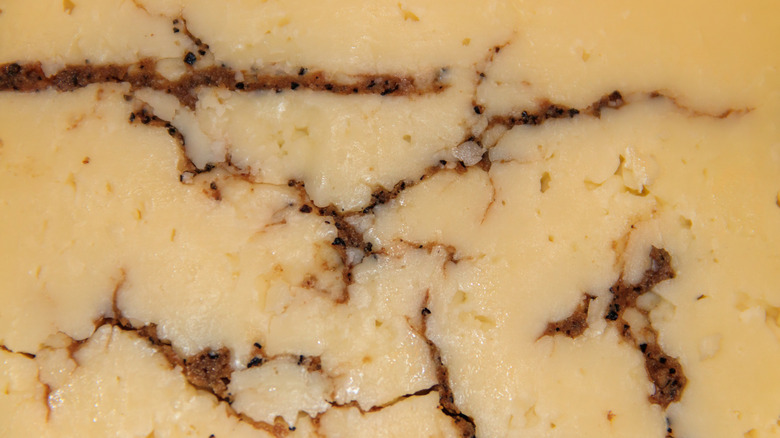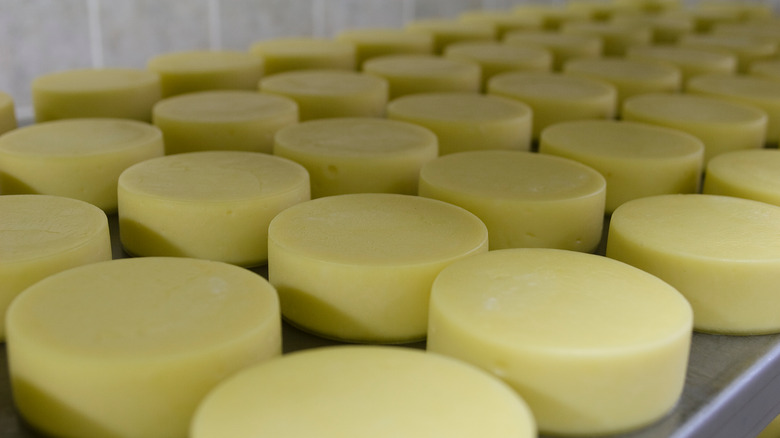The Difference Between Expensive And Cheap Cheese
Head into any supermarket, and you'll find that the cheese aisle boasts a wide range of prices. Some cheeses are relatively affordable, like Cracker Barrel cheddar, which frequently fetches less than $4 per half-pound block. Others tout their luxury status with prices that can range from $9 for the same weight of double cream brie to a whopping $20 for the same amount of pretty flower-covered Alp Blossom. And that's not even the upper limit of what you may find yourself paying for cheese, with the world's most expensive cheese to date fetching a whopping 30,000 euros for a 2.2-kilogram wheel. That amounts to about $3,400 for eight ounces of the stuff.
So what contributes to the expense of what is, at its core, basically spoiled milk? A lot of factors, including rising costs for feed, fuel, labor, packaging (the latter of which, as Jasper Hill tells Janet Fletcher of Planet Cheese, have gone up 30% in the past year), and more. To understand what makes cheese so expensive — and whether it's worth the cost — we've dug deep into the differences between cheap and expensive cheese. Here's what we discovered.
Long-aged cheeses are usually more expensive
Most cheeses begin the same way, with milk being coagulated into curds and whey. But whereas some fresh cheeses are ready to sell in a matter of hours or days, other cheeses, particularly hard cheeses, need to age to their perfect doneness. A period of several months — or even several years — in specially designed cellars boasting constant, ideal temperatures and humidity helps cheeses like Alpine Gruyère or extra-aged cheddars develop the rich, buttery, nutty aromas we associate with these hard cheeses. The process also helps these cheeses develop calcium lactate crystals, which crunch under the teeth in a burst of savory, umami richness.
But time, in this case, is money.
Every day a cheese occupies space on the shelf comes at a cost to the cheesemaker, who cannot use that space for anything else. Think of the added cost to the consumer as rent: A Parmigiano-Reggiano aged for 12 months has taken up space for a year less than a coveted 24. And that's not all. A long-aged cheese must be flipped, brushed, and cared for — and this requires manpower. A wheel of Uplands' Pleasant Ridge Reserve, for example, incurs $3 a month in carrying costs, as the company told Serious Eats. That holds even truer for extra-old cheeses like Bitto Storico, which, at 15 to 18 years of age, is regarded as the oldest edible cheese in the world and costs a whopping $150 per pound.
Fresh cheeses can be made and sold quickly, making them cheaper
Seeing as long-aged cheeses cost more, it stands to reason that one can lower the price of one's cheese budget significantly by opting for younger varieties. Fresh cheeses like feta, chèvre, or mozzarella may be made with similar artisanal attention to detail as some harder cheeses but cost less due to a number of factors.
Fresh cheese costs less largely because it requires less milk to produce than aged cheese. Harder cheeses attain their dense texture due to water loss, which means that the same amount of milk results in less cheese than a fresh variety. For instance, one gallon of milk will produce approximately 1.1 pounds of feta, compared to just 0.6 pounds of Parmesan. In other words, a cheese producer gets more bang for their buck when producing fresh cheese and thus can afford to pass those savings on to the consumer.
Fresh cheeses also require less work after they have been formed. As opposed to the brushing, turning, and cave-aging that is demanded by the process of crafting more expensive hard cheeses, fresh cheeses can often be sold immediately or nearly immediately after being produced. Fresh chèvre, for example, is typically ready to eat in just two to three weeks; feta, meanwhile, can be marketed in just two to three days. It's no surprise these quick-to-make cheeses are cheaper than their long-aged counterparts.
Inexpensive commodity milk lowers the price of cheap cheese
One major distinguishing factor between cheap and expensive cheese is the core ingredient: milk. Industrial cheese producers likely rely on commodity milk, whose price is set by the market and pricing regulations. Smaller producers, meanwhile, might choose to purchase local, organic, or grass-fed milk directly from producers at a premium, or even raise their own dairy cows, which means they'll need to pay to refine the milk as well. These added costs may double the price of the milk alone, and it all trickles down to the price the consumer pays for the resulting cheese.
The cost of premium milk isn't just linked to the added work and space required when raising dairy cows on pasture. It may also be the result of the volume of milk produced by different breeds. Modern Holsteins produce between 5.8 to 10.5 gallons of milk per day as compared to French Normandes, which produce just 3.4. But the milk of the latter is sought-after for its high concentration of protein and fat, not to mention its digestibility and distinct flavor. The cost of raising and feeding a cow, be it a Normande or a Holstein or another breed, doesn't change depending on how much milk the cow produces. So, the reduced yield sees the price of the cheese spike as a result.
European subsidies help make imported cheese less expensive
Foreign products are often more expensive than homegrown ones due to taxes and the cost of transport. However, foreign cheese isn't necessarily more expensive than artisanal American iterations. Often, the opposite is true.
Many European countries subsidize their cheese production as a means of protecting time-honored traditions. These subsidies can represent as much as 40% of a farmer's income. American dairy farmers, meanwhile, generally do not receive subsidies from the government and must make all of their income from selling the cheese alone. Despite taxes on European imports that can amount to 300% or more of the value of the cheese, some artisanally-crafted American cheeses are more expensive than their European counterparts.
This is the case for cheeses like spruce-wrapped Winnimere from Vermont's Jasper Hills, which costs somewhere around $48 per pound, as compared to the similar spruce bark-wrapped Vacherin Mont d'Or, which costs only six dollars more, despite being imported from France.
One of the world's most expensive cheeses is made from donkey's milk
Most of the world's cheese is made from the milk of one of three animals: cows, goats, or sheep. But some makers capitalize on other milks, such as the rich water buffalo milk that forms the base of Campania's famous buffalo mozzarella (also known as mozzarella di bufala), or even rarer delicacies like the camel's milk used to make the aptly named Camelbert.
But perhaps the world's most expensive cheese — and one that you ought to try at least once in your life if you can find it — is made from the milk of a pretty surprising animal. Donkey's milk pule is produced by just one farm in Serbia's Zasavica Special Nature Reserve and sells for $600 per pound. The cost of the cheese comes down to several factors, including the need for more than six gallons of Balkan donkey milk to make just a kilogram of cheese. That's nearly triple the milk needs of other cheeses. Since donkeys typically don't produce much milk, to begin with — just over a quarter of a gallon a day, compared to the three or four times as much produced by dairy cows — and seeing as donkeys can only be milked during a six-month season, and it's easy to understand why this cheese would fetch such a high price.
Rare cheeses are in high demand
The laws of supply and demand dictate that a rare product will oftentimes fetch a high price, so it's no surprise that the rarity of some cheeses can contribute to a slightly scary price tag. Factors contributing to the rarity of a cheese can vary. Perhaps, like pule, they're only made by one producer in the world. Maybe they require the milk of a rare breed of animal, like Caciocavallo, made with the milk of the rare Podolica cow, known for its hardiness and ability to survive the harsh mountainous conditions of southern Italy.
The rarity of a cheese may also be an intentional choice made by cheesemakers. Such is the case of Cathedral City, a cheesemaking company that makes just 77,000 tons of cheese a year, far below the upper limit for recognition as an artisan cheesemaker (which comes in at 400,000 tons a year). Whatever the reason, low supply in the face of high demand will certainly increase the price point of the resulting cheese.
You may spend more for a seasonal cheese
One reason a cheese could be rare is that it's only produced seasonally. This is the case for the French and Swiss Vacherin Mont d'Or, which is only made from mid-August to mid-March and is particularly beloved in winter, when turophiles (that is, cheese connoisseurs) bake it and drizzle the warm cheese over potatoes and charcuterie. Likewise, the innate seasonality of moose milk, made in Sweden's Bjurholm region at The Moose House, means that this cheese can only be produced from May to September, contributing to a price of $500 per pound.
The shorter the season, the more sought-after and expensive the cheese will be. Rogue River Blue, made by wrapping aged organic blue cheese in vine leaves that have been soaked in pear brandy, is one such cheese. Its seasonality means the cheese is only available in November and December. As a bonus, ever since it took the World Champion title at the 2019/2020 World Cheese Awards, Rogue River Blue has become exceedingly difficult to find. When you do, it's understandably fairly pricey, at $75 per pound.
Added ingredients may add to the cost
While some cheese producers begin their production with expensive grass-fed or organic milk, other producers one-up the cost of this staple ingredient by adding other expensive seasonings to the mix. White Stilton Gold is one of the world's most expensive cow's milk cheeses, thanks to being bedazzled with edible gold leaf. Originally produced as a Christmas special, this sparkly cheese is now made year-round and typically fetches about $400 per pound.
Gold leaf adds bling, if not much flavor. But other additives make cheese more delicious as well as more expensive, such as truffle. Truffles are unique fungi whose rarity contributes to a price that can range from $300 for black truffles to a whopping $4,000 for white. When added to cheese, they understandably increase the price point significantly. Murray's Cheese sells six-month-old Grafton Village Cheddar infused with black truffle for $14 per eight-ounce block. The same cheese, aged twice as long but without the benefit of added truffles, costs a dollar less.
Highly prized cheeses make it to auction houses
A cheese of sufficient esteem may find its price dictated not so much by the market but by an auctioneer. Such was the case of one Spanish blue cheese known as cabrales, produced by Guillermo Pendás for his family facility in Asturias. The cabrales was recognized as the region's best of the year in 2023 and subsequently broke the world record for most expensive cheese, with a 2.2-kilogram wheel selling for €30,000 (about $32,600 for just under five pounds of cheese). The cabrales had been aged in a mountain cave for at least eight months and brought down on foot. The lucky buyer was restaurateur Iván Suárez, who had also purchased the previous record-breaking cheese — another cabrales — in 2019, this time for the comparatively paltry sum of $16,142.41 for the 5.78-pound wheel.
Cabrales is one of the most expensive cheeses in the world and is governed by strict Denomination of Protected Origin (DOP) rules that include aging within the natural limestone caves of the Picos de Europa National Park in Asturias. The resulting cheeses are known for their sharpness, richness, and pungency. The rarity of the cheese and the hard work that goes into it results in an average price of $30 per pound — definitely on the higher side, but far more reasonable than the prices Suárez paid.
Cheap cheese is often less complex in flavor
When you see the prices fetched by expensive cheeses, it's tempting to opt for the cheapest ones you can find. But there's a reason why artisan cheeses are more expensive — and it's not just down to the work it takes to produce them. Cheap cheese is often less complex in aroma and flavor. Cheap cheddars, for example, have a sharp, almost acrid flavor and a potentially rubbery texture. Cheeses that have had their shelf lives extended by preservatives and vacuum-sealing in plastic will also likely taste more artificial and less alive than their artisan counterparts.
Cheese expert Liz Thorpe had no problem identifying the difference between cheap and expensive cheeses blind in a video produced for Epicurious. The less expensive, more industrial brie-style cheese had a narrower flavor profile, devoid of the sought-after cruciferous vegetable flair that gave a more expensive brie the flavor of a broccoli cheddar soup. Expensive, cloth-bound cheddar, meanwhile, had more woodsy, vegetal aromas than the inexpensive, industrial block cheddar she tried. While not bad by any means, cheaper iterations of these and other cheeses often just lack the complexity of pricier versions.
Industrially-made cheeses capitalize on lower costs and bulk buying
Artisanal cheesemakers incur quite a few overhead costs in their endeavor to make great cheese, whether that's using their own dairy herd or drawing on organic ingredients. Industrial producers, meanwhile, can take full advantage of a few benefits of their size to keep costs lower, such as buying commodity milk and mechanizing production to cut down on the manpower required. Cutting costs in this way ultimately reduces the price of the cheese for the consumer.
Of course, just because a cheese is industrially produced doesn't necessarily mean it's bad. Cheesemongers can point you in the direction of great-quality industrial cheeses, like Fromager d'Affinois, a triple-cream brie-style cheese that Zach Berg, cheesemonger and owner of Detroit's Mongers' Provisions, tells CNET he loves despite its industrial status. Berg also recommends the cheeses produced by industrial producers Mitica/Forever Cheese and Hook's. Your local cheesemonger might have even more suggestions for cheeses that taste delicious but don't break the bank.
The cut matters when it comes to expensive cheese
One way you can save money when buying otherwise expensive cheese is by taking advantage of offcuts or less desired pieces. Some cheesemongers will set aside odd or inelegant cuts of great cheese to sell at a discount. These may include small or strangely shaped wedges left over from portioning out a larger block, or pieces that have a higher rind-to-paste ratio.
Speaking of which, even if your cheese shop doesn't sell wonky wedges at a reduced price, you can take advantage of how the cheese is sliced to get a better bang for your buck. Cheeses like Parmesan are often cut into wedges that boast a fair bit of rind, which, while a delicious addition to soups and broths, is far from appetizing to eat on its own. Since Parmesan rind contributes to the weight of the cheese, choosing a rind-heavy piece means you'll be paying more for less cheese. Search the bin to find the wedge with the least rind, and you'll be reaping the best value.












